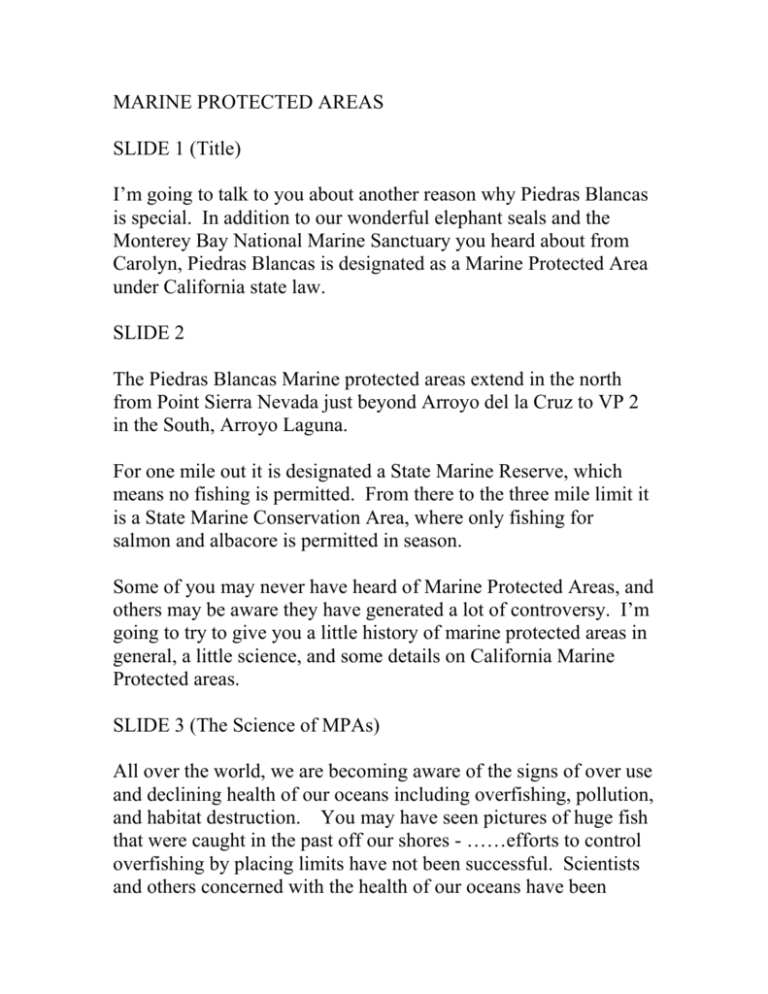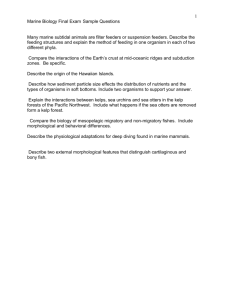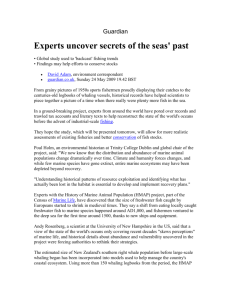MARINE PROTECTED AREAS - California MPA Educational
advertisement

MARINE PROTECTED AREAS SLIDE 1 (Title) I’m going to talk to you about another reason why Piedras Blancas is special. In addition to our wonderful elephant seals and the Monterey Bay National Marine Sanctuary you heard about from Carolyn, Piedras Blancas is designated as a Marine Protected Area under California state law. SLIDE 2 The Piedras Blancas Marine protected areas extend in the north from Point Sierra Nevada just beyond Arroyo del la Cruz to VP 2 in the South, Arroyo Laguna. For one mile out it is designated a State Marine Reserve, which means no fishing is permitted. From there to the three mile limit it is a State Marine Conservation Area, where only fishing for salmon and albacore is permitted in season. Some of you may never have heard of Marine Protected Areas, and others may be aware they have generated a lot of controversy. I’m going to try to give you a little history of marine protected areas in general, a little science, and some details on California Marine Protected areas. SLIDE 3 (The Science of MPAs) All over the world, we are becoming aware of the signs of over use and declining health of our oceans including overfishing, pollution, and habitat destruction. You may have seen pictures of huge fish that were caught in the past off our shores - ……efforts to control overfishing by placing limits have not been successful. Scientists and others concerned with the health of our oceans have been putting a lot of focus on protected areas as a tool to protect our ocean ecosystems. Marine reserves have been used in the past, and have been shown to improve ocean health. SLIDE 4 (Anacapa Island) For example, a marine reserve established by the National Park Service at Anacapa Island has been monitored for 20 years and compared with nearby fished areas. The marine reserve has a healthy kelp forest, which has persisted through that time. However, outside of the reserve the kelp forest has become barren during El nino events. Any ideas as to why? The difference is caused by the effects of fishing, specifically spiny lobsters. In the reserve, lobsters were 6 times as abundant as in the fished area. They ate more urchins, which graze on kelp. Eliminating fishing restored the natural balance that kept the kelp forest healthy. There are lots of examples of increased number of fish in protected areas But Marine protected areas also have been effective in increasing the number of fish outside of the protected areas and will improve fishing outside of those areas over time. How does that work? SLIDE 5 (Vermillion rockfish) This is the BOFFFF example – the big fat, female, fecund fish. Fish in protected areas will grow larger, and larger fish produce significantly more offspring. In this case, a 7.5 pound rockfish will produce 10 times more offspring than a 1.8 pound fish. And like with elephant seals, the young of the older larger fish are more likely to survive. So how does that improve fishing outside of the protected areas? SLIDE 6 (How No Take Marine Reserves Work) While the adults tend to stay in a particular area, offspring will drift into adjacent areas, increasing the number of fish, which improves fishing. SLIDE 7 (state law) The state of California attempted to take this science into account in establishing the California Marine Life Protection Act of 1999, which requires a comprehensive science-based network of protected areas to foster healthy habitats and improve fishing. SLIDE 8 (state law) The plan was to establish a statewide network by 2011. The state was divided into five study regions, with each region going through a lengthy process of community meetings involving stakeholders such as commercial and recreational fishers, environmentalists, and tour operators along with a science advisory team, a blue ribbon task force and the California department of fish and game Central Coast was the first region to be completed in 2007 – the North Central Coast was just completed and other areas are in process except for San Francisco Bay, which is expected to start late this year. Quite a bit of controversy – the south coast group submitted 3 proposals. SLIDE 9 (Central Coast) This chart shows all the MPA’s along the Central Coast, from Pigeon Point in San Mateo County to Point Conception in Santa Barbara County The areas are spaced to encourage repopulation – SLIDE 10 (Central Coast) There are 29 protected areas on the central coast – 13 marine reserves prohibit fishing, which is 7.5% of the area 14 marine conservation areas limit fishing – 10% of the area Others of interest to visitors from this area may be the SMCA in Cambria and the Morro Bay State Marine Recreation Management Area, where resources may be taken by special permit or license. Hunting of Brandt is permitted in Morro Bay. SLIDE 11 (back to Piedras Blancas) The Piedras Blancas MPAs, were selected for a number of reasons including the elephant seal rookery, our other marine mammals and the extensive kelp forest. Offshore a deepwater rocky reef attracts large forage fish populations and provides shelter for rockfish SLIDE 12 (monitoring) Scientific monitoring to evaluate effectiveness is an important part of the MPA process Monitoring includes catch and release fishing and netting, and observation by submersibles You may see evidence of monitoring from the bluffs. SLIDE 13 (interpretation) When we are on the bluffs talking to our visitors about the elephant seals, we should take the opportunity to mention the broader unique marine environment of this area, where marine life and habitats have been given the opportunity to recover We recently received a grant from the Monterey Bay Sanctuary Foundation to provide us with materials so that both our docents and our visitors can learn more about MPAs. (Packs, notebooks)








